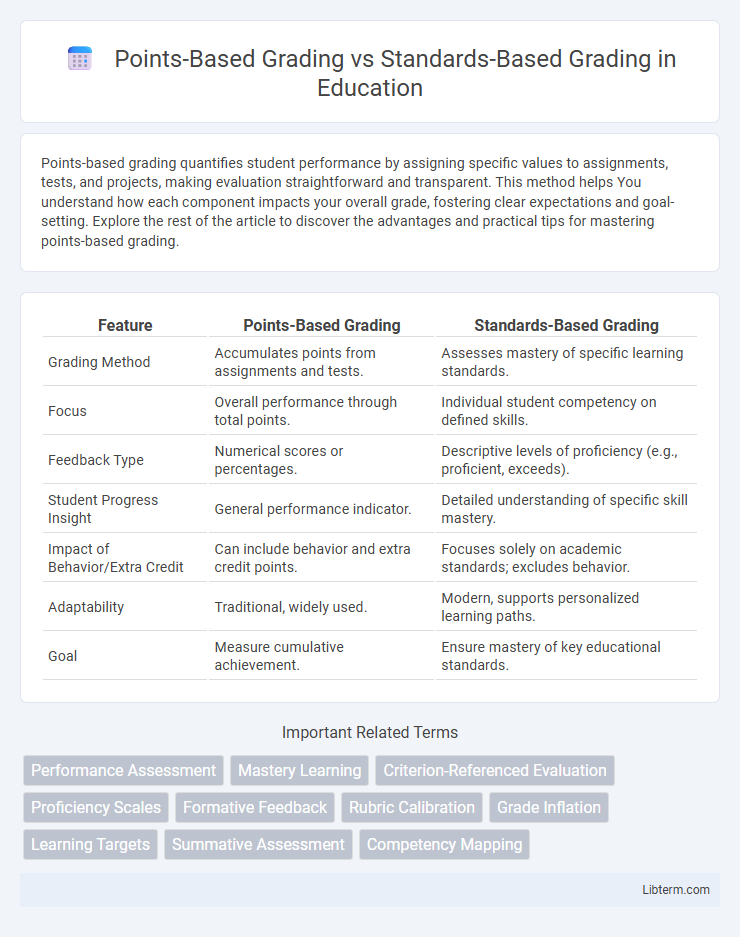Points-based grading quantifies student performance by assigning specific values to assignments, tests, and projects, making evaluation straightforward and transparent. This method helps You understand how each component impacts your overall grade, fostering clear expectations and goal-setting. Explore the rest of the article to discover the advantages and practical tips for mastering points-based grading.
Table of Comparison
| Feature | Points-Based Grading | Standards-Based Grading |
|---|---|---|
| Grading Method | Accumulates points from assignments and tests. | Assesses mastery of specific learning standards. |
| Focus | Overall performance through total points. | Individual student competency on defined skills. |
| Feedback Type | Numerical scores or percentages. | Descriptive levels of proficiency (e.g., proficient, exceeds). |
| Student Progress Insight | General performance indicator. | Detailed understanding of specific skill mastery. |
| Impact of Behavior/Extra Credit | Can include behavior and extra credit points. | Focuses solely on academic standards; excludes behavior. |
| Adaptability | Traditional, widely used. | Modern, supports personalized learning paths. |
| Goal | Measure cumulative achievement. | Ensure mastery of key educational standards. |
Introduction to Grading Systems
Points-Based Grading assigns numerical values to individual assignments, accumulating to form a total score that determines a student's grade. Standards-Based Grading evaluates students' mastery of specific learning objectives or standards, emphasizing proficiency over accumulated points. Understanding these grading systems helps educators align assessment methods with instructional goals and student learning outcomes.
What is Points-Based Grading?
Points-Based Grading assigns numerical values to assignments, tests, and participation, aggregating scores to calculate a final grade. This traditional grading system emphasizes accumulation of points earned versus points possible, often leading to a cumulative percentage or letter grade. Points-Based Grading may not always reflect mastery of specific learning standards, as it aggregates all work without differentiating learning objectives.
What is Standards-Based Grading?
Standards-Based Grading (SBG) evaluates student performance based on mastery of specific learning objectives rather than accumulating points from various assignments. This approach measures how well students understand and apply essential skills aligned with curriculum standards, providing clear feedback on areas needing improvement. SBG emphasizes proficiency over traditional percentage scores, promoting growth and targeted instruction.
Key Differences Between Points-Based and Standards-Based Grading
Points-based grading assesses student performance through cumulative scores on assignments and tests, emphasizing numerical totals and averages to determine final grades. Standards-based grading evaluates mastery of specific learning objectives, providing detailed feedback on proficiency levels for each standard rather than overall points. The key difference lies in points-based grading's focus on accumulation of scores versus standards-based grading's emphasis on demonstrated competency in distinct academic skills.
Pros and Cons of Points-Based Grading
Points-Based Grading offers a straightforward and familiar method for assessing student performance by assigning numerical values to assignments, quizzes, and exams, making it easy for students and parents to understand overall progress. However, this system often emphasizes quantity over quality, potentially encouraging students to focus on accumulating points rather than mastering learning objectives. Critics also argue that points-based grading can obscure specific skill deficiencies, as detailed feedback may be limited and averaging may mask areas needing improvement.
Pros and Cons of Standards-Based Grading
Standards-Based Grading (SBG) provides clear, specific feedback on students' mastery of individual learning goals, promoting targeted skill development and personalized instruction. However, SBG can be time-consuming for educators to implement and may challenge traditional reporting systems, requiring significant adjustments in grading practices and parent communication. Despite these drawbacks, SBG enhances transparency and helps identify learning gaps more effectively than traditional points-based grading systems.
Impact on Student Motivation and Learning
Points-Based Grading often emphasizes competition and numerical achievement, which can motivate students focused on grades but may reduce intrinsic motivation and deep learning. Standards-Based Grading highlights mastery of skills and knowledge, promoting a growth mindset and encouraging students to focus on understanding rather than just earning points. Research shows that Standards-Based Grading enhances student engagement and persistence by providing clear learning goals and feedback aligned with competencies.
Teacher and Parent Perspectives
Teachers often find points-based grading straightforward for quantifying student performance but recognize standards-based grading provides clearer insight into mastery of specific skills. Parents appreciate standards-based grading for offering a detailed understanding of their child's progress toward learning objectives, though some may find points-based grades easier to interpret at a glance. Both perspectives highlight the need for transparent communication to effectively support student development.
Implementation Challenges and Solutions
Implementation challenges in points-based grading often include grade inflation, lack of clarity on skill mastery, and difficulty in providing meaningful feedback, while standards-based grading faces obstacles like aligning assessments with standards, teacher training, and ensuring consistent proficiency levels. Solutions for points-based grading involve adopting rubrics and continuous assessment to enhance transparency and fairness, whereas standards-based grading benefits from targeted professional development, clear communication of standards to students and parents, and using data-driven tools to track performance. Both systems require robust technological support and stakeholder engagement to effectively address these challenges and improve learning outcomes.
Choosing the Best Grading System for Your Classroom
Choosing the best grading system for your classroom depends on aligning assessment methods with learning goals; points-based grading quantifies student performance through accumulated scores, while standards-based grading evaluates mastery of specific skills or standards. Research indicates standards-based grading improves student understanding by clearly communicating learning targets and reducing the emphasis on extra credit or behavioral factors. Educators should consider the impact on student motivation, feedback clarity, and curriculum alignment when deciding which system best supports academic growth and fairness.
Points-Based Grading Infographic

 libterm.com
libterm.com